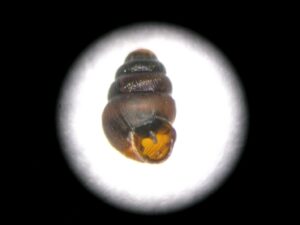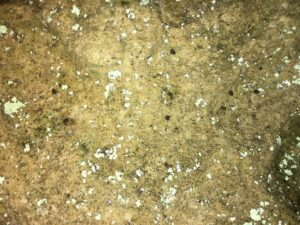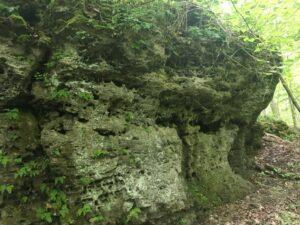By Bernheim

On May 10, 2019, Bernheim snail researchers located a population of the globally imperiled bluff vertigo (Vertigo meramecensis), known from less than 30 populations in the world. The snails were found on a rock outcrop located directly in the path of the proposed LG&E natural gas pipeline. This proposed pipeline route cuts through Bernheim Forest’s Cedar Grove Wildlife Corridor, an area known for its protection of federally endangered plants and animals including Kentucky glade cress, Indiana bat, northern long eared bat, and other rare and imperiled species.
Led by Lori Schroeder and Dr. Harry Lee, principal investigators for the Bernheim Land Snail Inventory for ten years, the project has documented 82 species from Bernheim with many being exceptionally rare and cryptic in nature. In 2013, Schroeder made the first discovery of the rare snail bluff vertigo in Kentucky in the area within Bernheim known as Cave Hollow, which is part of the Cedar Grove Wildlife Corridor, on similar habitat near a cave entrance. DNA work confirmed the specimen’s identity in Cave Hollow as Vertigo meramecensis.
Listed as a globally imperiled G2 species by Natureserve, the species is known to exist in fewer than 30 sites in the world. It is extremely susceptible to disturbance from human activities that destroy habitats through demolition of rock outcrops and clearing of forest that provides microclimates needed for this species. Believed to be a glacial relict species, the known sites for the bluff vertigo snail are highly specialized and consist of forested limestone rock outcroppings along streams. The microclimates found on limestone outcroppings in Bernheim are critical for protecting the bluff vertigo from climate change and temperature extremes.

This species has been found in Kentucky on three forested streams in Bernheim with karst springs and limestone outcroppings. Management to preserve these isolated populations includes minimizing disturbances and forest clearing that would alter their microclimate and likely lead to destruction of these fragile populations. Construction of the proposed natural gas pipeline would likely destroy the entire Cedar Creek population.
Bernheim Forest learned in 2018 that the Louisville Gas and Electric (LG&E) Bullitt County Natural Gas Pipeline is proposed to cut directly across the Cedar Grove Wildlife Corridor. The route across Bernheim is protected by a conservation easement and deed restrictions prohibiting destruction of natural resources or transfer of property for non-conservation purposes. The LG&E Bullitt County Natural Gas Pipeline would destroy forests, springs, streams, and outcroppings that include critical habitat for imperiled wildlife species, including four federally endangered plants and animals.
Bernheim Forest management and Board of Trustees are opposing the project and have let LG&E and local officials know of their intention to deny the pipeline easement and to vigorously fight any action that would include taking of Bernheim’s land through eminent domain. Bernheim contends that wildlife and nearby communities receive incredible benefits from the protected forest that functions for habitat and provide ecosystem services of clean air, water, and scenic values.

Construction activities by LG&E would certainly destroy this forested habitat used by the imperiled bluff vertigo snail on Cedar Creek. The proposed LG&E pipeline is targeting an area in Bernheim protected by conservation easements and deed restrictions specifically requiring forests be protected, natural features not be damaged, and destructive projects such as this proposed pipeline not be allowed. Bernheim is committed to standing by these deeded commitments to conservation. With a 90-year history in protecting and restoring wildlife, forests, streams, and providing nature based education, Bernheim does not see this natural gas pipeline as being compatible with our long term plans for the site or for the continued existence of the bluff vertigo snail.

